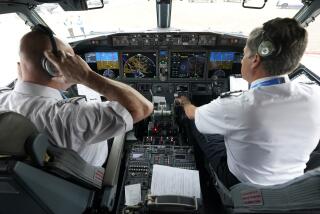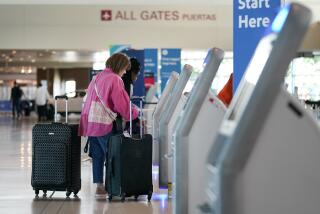Proposed federal rules aim to ease pilot fatigue
- Share via
Reacting to the deadly crash of a regional airliner in western New York early last year, federal regulators Friday unveiled a long-awaited proposal to combat fatigue among commercial pilots by requiring longer rest periods, shorter times on duty and limits on the number of hours they can fly.
The proposed rules, however, do not address one of the key issues raised by the February 2009 Colgan Air crash — the long and potentially tiring commutes, sometime over hundreds of miles, that many regional airline pilots make before reporting for work.
“This proposal will protect the 700 million airline passengers who fly every year,” said Secretary of Transportation Ray LaHood at a news conference in Washington. “The Colgan crash families were a strong advocate for the new rules. They put the wind in our sails to do something. No one has paid a greater price. We are grateful to them.”
The crash of Colgan’s twin-engine turbo prop killed 50 people near Buffalo, N.Y., and raised broad questions about training, long hours, and working conditions for regional airline pilots. After the disaster, the Obama administration identified fatigue in the airline industry as a top priority for federal regulators.
Officials for the Regional Airline Assn. and the Air Transport Assn. said they supported efforts to reduce fatigue and have voluntarily taken some steps to deal with the problem.
“The Air Transport Assn. has long been on record in support of pilot-rest and fatigue management rules that are science-based, effective and crafted to truly improve safety,” said Victoria Day, an association spokeswoman. “We will be evaluating the FAA pilot fatigue rule against that standard.”
If adopted after a review period, the proposals by the Federal Aviation Administration would require that airline pilots get a minimum of nine hours’ rest starting when they arrive at their homes, hotels or apartments after work. The measures seek to ensure that the pilot has the chance to get eight hours of actual sleep during the rest period.
This would be a significant change over current rules, which have been largely unchanged since the 1940s. They require a minimum of eight hours’ rest between shifts, including commute times between the airport and the hotel.
Under the new proposals, pilots who feel they are too tired to fly also can decline to take flights without fear of reprimand or discipline by employers — something pilots have complained about in the past.
The time a pilot spends on duty, which includes flying, flight checks, and waiting between flights, would be limited to 13 hours a day depending on the number of hours flown, the number of flights and a pilot’s starting time, such as very early in the morning. The current limit is 16 hours.
The rules address cumulative fatigue by placing weekly and 28-day limits on the amount of time a pilot may be assigned to any type of duty. In addition, 28-day and annual limits would be placed on the hours a pilot flies. Today, a pilot can fly no more than eight hours per 24 hours.
According to the FAA, these changes would provide pilots at least 30 consecutive hours off on a weekly basis — a 25% increase over current rules.
Under the proposals, the amount of rest or time off would be determined based on the time of day, the number of scheduled flights, the time zones pilots fly through, the type of flights, and the likelihood that a pilot is able to sleep under different circumstances.
“I know firsthand that fighting fatigue is a serious issue, and it is the joint responsibility of both the airline and the pilot,” said FAA Administrator Randy Babbitt. “After years of debate, the aviation community is moving forward to give pilots the tools they need to manage fatigue and fly safely.”
Federal officials said that if the rules are adopted, airlines may face higher costs and need to hire more pilots. Some of those costs, they said, could be reduced with better scheduling of air crews and flights.
The rules will not be final until the public, airlines, pilots, safety experts and government regulators such as the National Transportation Safety Board get to comment in writing during the next 60 days. The FAA has until Aug. 1, 2011, to evaluate the comments, make changes and approve the regulations.
If approved, the new rules will represent a substantial improvement in the effort to fight fatigue in the airline industry — something the NTSB called attention to more than 20 years ago when it requested regulations.
Proposals to reduce fatigue, however, have faced opposition over the years from the airline industry, which has managed to repeatedly thwart regulatory efforts by the federal government.
Congress only recently mandated that all air carriers with the assistance of the FAA develop fatigue management plans, and the FAA has yet to determine whether to do something about the long commutes made by airline pilots.
Federal hearings related to the Buffalo-area crash revealed, for example, that scores of Colgan pilots who were based in Newark, N.J., commuted anywhere from 400 to 1,000 miles by plane before reporting for work.
“Why do these things take so long?” Babbitt said. “There are lots of people involved, lots of stakeholders, and lots of issues that need to be addressed. This has taken too long. But from the Colgan Air crash to where we are now, we have done a lot better than other administrations.”
dan.weikel@latimes.com
More to Read
Inside the business of entertainment
The Wide Shot brings you news, analysis and insights on everything from streaming wars to production — and what it all means for the future.
You may occasionally receive promotional content from the Los Angeles Times.











